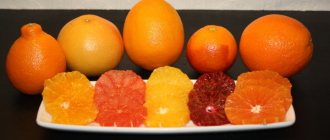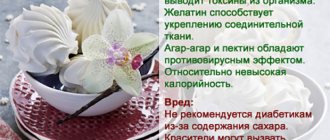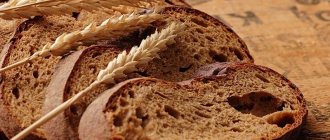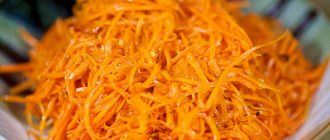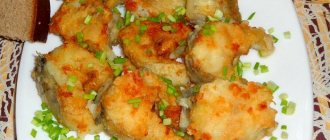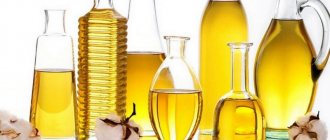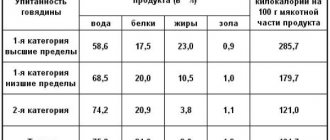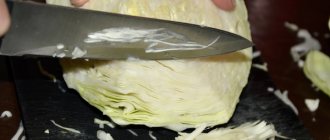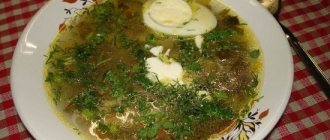Korean carrots are one of the most popular East Asian dishes common in our country. Many housewives even learn to prepare this universal snack on their own. Korean carrots not only have an amazing taste, but also many essential substances for the body. Its benefits are also of interest to supporters of a healthy diet, however, they face the need to reduce the very high calorie content of the product (112 kcal per 100 grams).
Chemical composition of carrots in Korean
Raw carrots are a valuable source of nutrients. As part of the snack, the root vegetable, which is not subjected to heat treatment, retains its properties. Some additional components can increase its benefits.
The table below provides information on the amount of nutrients in 1 serving of classic Korean carrots:
| Amount of vitamins and minerals per 100 g (in mg) | % of daily value | |
| Vitamins | ||
| A | 6.9 | 767% |
| IN 1 | 0.05 | 4% |
| AT 2 | 0.06 | 4% |
| AT 5 | 0.2 | 6% |
| AT 6 | 0.1 | 7% |
| AT 9 | 0.006 | 1.7% |
| WITH | 4.2 | 6% |
| E | 3.9 | 5% |
| N | 0.05 mcg | 0.1% |
| RR | 0.999 | 5% |
| Minerals | ||
| Potassium | 164 | 8% |
| Calcium | 38 | 3% |
| Magnesium | 30 | 10% |
| Sodium | 27 | 2% |
| Phosphorus | 46 | 7% |
| Gland | 0.7 | 4% |
| Iodine | 0.004 | 2.8% |
| Copper | 0.073 | 7% |
| Fluorine | 0.042 | 1.1% |
| Zinc | 0.000362 | 3% |
Heh from halibut
Photo: K-Grill Restaurant
100 g of raw halibut (you can use any white fish - editor's note)
- 20 g onions
- 40 g bell pepper
- 30 g tomatoes
- 20 g soy sauce
- 10 g rice vinegar
- 3 g cilantro
- 10 g chili pepper
Step 1. Cut the raw fish into slices and marinate in rice vinegar with salt and pepper to taste for 5 minutes.
Step 2. Cut onions, bell peppers, tomatoes and chili peppers into thin slices.
Step 3. Pour soy sauce over chopped onions, bell peppers, tomatoes, chili peppers and pickled halibut and mix well.
Step 4. Place on a plate and garnish with a sprig of cilantro.
The benefits and harms of the dish
Eating salad in small portions brings the following positive effects:
- due to the peculiarities of the composition of the snack, the volume of gastric juice secreted increases, which has a beneficial effect on the functioning of the digestive system, increases the metabolic rate, and improves appetite;
- the high content of coarse fibers helps to cope with constipation;
- spices have anthelmintic and expectorant properties; the antiseptic and immunostimulating effect of spices helps the body resist infection during seasonal diseases;
- carotene is necessary to improve vision;
- B vitamins have a positive effect on the condition of capillaries; The vasodilating effect of vitamin PP has a beneficial effect on the condition of blood vessels and heart function.
Excessive consumption of spicy snacks can:
- cause disruption of the gastrointestinal tract, heartburn as a result of irritation of the esophageal mucosa;
- increase the secretion of gastric juice, acidity;
- lead to an excess of vitamin A, which leads to yellowing of the skin.
Due to a possible negative reaction from eating this dish, it is recommended to refrain from:
- during pregnancy and breastfeeding (substances that are harmful and difficult to digest for the infant’s fragile digestive system will pass into breast milk);
- for inflammation of the gastric mucosa (ulcer, gastritis);
- for liver disease, kidney disease, pancreatitis;
- with a tendency to allergic reactions, intestinal disorders;
- with excess vitamin A.
It is also not recommended to introduce this dish into a child’s diet.
Heh
Another example of an interesting transformation of a dish in Tashkent is fish heh (khweh, to be precise). Originally, hwe is a cutting method, like the Japanese use of sashimi. It's just fish, cut into pieces, served with sauces and eaten by dipping in them.
Koreans in Tashkent encountered freshwater fish; they mainly caught carp there, and it smells like silt. So the Koreans marinated it with vinegar, added pepper and herbs. It turned out to be a fish heh. And other products began to be prepared using the same principle. Heh can now be made from beef heart and chicken navels. Now heh - this is the way to refuel.
Article on the topic
In facts and figures: Koreans eat 5 times less meat per year than Americans
Contents of the BZHU
The optimal balance in the ratio of BJU, according to nutritionists, is the following indicator:
- 10 to 35% of calories should come from protein;
- 25 to 35% from fat;
- 45 to 65% from carbohydrates.
Depending on the composition, the BJU indicators of Korean carrots may fluctuate. On average, the numbers are as follows: proteins - 1.25 g (1% of the daily value), fats - 8.2 g (12%), carbohydrates - 9.8 g (6%). If we analyze the contribution of BJU to calorie content, we obtain the following figures: 4.2% proteins, 64.4% fats, 31.4% carbohydrates.
The product does not fully comply with healthy nutrition standards due to its low protein content. The salad also contains: dietary fiber (fiber) – 4.8 g (24%), ash – 1.1 g, water – 75.3 g (2.74%).
Secret 3. Spicy food
We’ve already talked about onions, garlic and kimchi, but Koreans eat spicy food everywhere and add spices to almost every dish, unless it’s dessert (however, spicy ice cream or caramel is not uncommon here either).
The tradition of active use of spices is directly related to the hot climate of Asia: hot seasonings have antibacterial properties and ensure the preservation of food. People invented refrigerators a long time ago, but the habit of eating spicy food in Asia remains. One of the most interesting authentic products is soy and soy-pepper pastes, which are used for marinades, salad dressings, and even simply as a spread on sandwiches. The degree of their spiciness can be determined by color: the hottest paste is red, gochudian.
Although pepper, ginger and other seasonings are indeed great for burning fat, Europeans should carefully introduce spicy foods into their diet and be sure to consult a doctor. Children are not given spicy food even in Korea: they are introduced to it gradually, starting from school age.
Calorie analysis
The table shows an analysis of the calorie content of the dish based on the classic ingredients of the recipe:
| Ingredient | Quantity (in g) | Calorie content, in kcal |
| Carrot | 1000 | 320 |
| Garlic | 20 | 29 |
| Ground pepper | 1.8 | 3 |
| Vegetable oil | 85 | 765 |
| Vinegar | 60 | 20 |
| Sugar | 30 | 120 |
| Salt | 35 | 0 |
| Ground coriander | 5 | 15 |
| Total | 1237 g | 1273 kcal |
Forums:
Better to cut raw carrots
Published Wed, 16/03/2016 — 10:52 by user ★★★Evgeniya★★★
It is better to cut raw carrots, add a little olive oil, pepper or any other favorite seasoning) Vegetables are best consumed raw.
Once you start, win!
So carrots in Korean and
Published Wed, 16/03/2016 — 11:03 by user Ira R
This is how Korean carrots are eaten raw, not boiled. There are just a lot of different spices.
yeah, spices, sugar, vinegar,
Published Wed, 16/03/2016 — 11:31 by user ★★★Evgeniya★★★
yeah, spices, sugar, vinegar, a lot of butter, and the calorie content is 100. And the raw one has about 32
Once you start, win!
I don't see any harm in spices!
Published Wed, 16/03/2016 — 12:53 by user Ira R
I don't see any harm in spices! I use very little vinegar and don’t add sugar at all. And then, what is 100 kcal per 100 g? But this is not for everybody! You like carrots without spices, but we like them with spices! Some people just nibble on cucumbers, while others dress them in salads and with butter. I believe that everything has a place to be. To each his own.
I don't think the author
Published Wed, 16/03/2016 — 13:13 by user ★★★Evgenia★★★
I don’t think the author was interested in homemade carrots. I have nothing against spices)) It’s just that a girl needs to lose a lot of weight and at the initial stage 100 calories per 100g and the same 100 calories per 300g, carrots are already much more significant in volume for filling the stomach. But this is just my personal opinion, I do not impose anything on anyone
Once you start, win!
And I agree with you. All
Published Wed, 16/03/2016 — 21:45 by user Merry Christmas tree
And I agree with you. You can and even need to eat everything, especially if you want to. The main thing is not to overdo it with quantity.
Valentina
I completely agree with you
Published Wed, 01/02/2017 — 00:08 by user Vesyola Yolka
I completely agree with you, there will be no harm from Korean carrots, you can’t eat a bucket anyway
I always add sugar to it, also garlic and lemon juice instead of vinegar, but I often forget butter. Valentina
Hello. Let's calculate
Published Wed, 16/03/2016 — 11:01 by user Ira R
Hello. Let's calculate the calorie content! I make it myself, but I’ve never counted calories. True, there are many recipes, let’s take the statistical average. Recipe: carrots - 500 g, onions - 1 piece (80 g) garlic - 2-3 cloves vegetable oil - 50-60 ml vinegar 9% - 1.5-2 tablespoons, coriander - 1/4 teaspoon, red hot ground pepper, ground black pepper, sugar - a pinch, salt I make it without sugar. In general, we won’t count the spices, this is what we get. See the bottom line, AND THAT IS 111 kcal per 100 GRAMS. But there is one BUT. This is salt. If you put in enough of it, the carrots will retain water. What is not good.
Irinka, you have a lot of oil
Published Wed, 02/01/2017 — 02:47 by AsyaYa
Irinka, you splashed a lot of oil into the morkoaka)) I actually didn’t calculate it myself when I did it, but before Maggi I ate the store-bought one, it says 82 k on the package, but I think that’s also approximate. Of course there’s no harm from it, but This makes me thirsty. If you make it yourself, you can simply use less hot pepper and salt. Well, it’s not for everyone. The reason I buy it is because it’s hot, and you can only eat a hundred to hundred fifty grams of it.
What determines the calorie content of pickled carrots?
Raw carrots have one of the lowest calorie content (32 kcal/100 g). The energy value is increased due to the presence of sauce, butter, and sugar in the composition.
The highest calorie ingredients are:
- butter (899 kcal per 100 g);
- sugar (398 kcal);
- sesame (440 kcal);
- soy asparagus (440 kcal).
The ability to independently regulate the amount of added products and completely exclude some components makes a dish prepared at home much healthier than one bought in a store. For example, when heated for a long time, the oil begins to release carcinogens harmful to the body. This can be avoided by keeping the cooking process under control.
conclusions
It is advisable to avoid eating Korean carrots on a diet, since this dish has more disadvantages than advantages. Although one-time consumption of a moderate amount of snack (50-100 grams) will not cause significant damage to your figure. The main thing is to combine this salad with protein foods, such as meat, to make your diet balanced. Also give preference to home-cooked dishes. Thanks to this, you can control the amount of added sugar and butter. The less you add these components to the salad, the more harmless it will be for your figure. The above tricks will allow you to enjoy your favorite Korean carrots on a diet!
Look at the same topic: Is it possible to eat sunflower seeds while on a diet or not?
Is it possible to eat while losing weight and include it in the proper nutrition menu?
Korean-style carrots, the calorie content of which is the sum of the components included in the composition, can be included in limited quantities in the healthy nutrition menu and when losing weight.
The main disadvantages that negatively affect the functioning of the digestive system and inhibit the process of losing weight:
- presence of sugar: can provoke a sharp jump in blood sugar; its excess negatively affects the body’s burning of fat, slowing down the process;
- spices (including vinegar) increase appetite, which can lead to overeating;
- a high content of seasonings and salt slows down the process of removing fluid from the body.
If we consider the ratio of BJU dishes, we can note the high fat content. 100 g of snack eaten will take up 15-30% of the recommended daily intake of fat per day, which is comparable to a full meal.
The positive aspects of including salad in the diet menu include:
- improvement of metabolism;
- high fiber content has a beneficial effect on intestinal function;
- the presence of ingredients with antiseptic properties.
Beneficial features
6 types of nuts that are recommended to be consumed when losing weight, and is it possible to eat the product at night?
The benefit of this salad is that it effectively replenishes vitamin deficiency. Each of us has heard since childhood that carrots help preserve and restore vision due to vitamin A. The root vegetable really holds the record for its content, and 100 grams of salad contains 767% (!) of the daily intake.
The high fiber content is also of great value (4.8 g per 100 grams, 25% of the norm). Coarse dietary fiber from carrots produces moderate irritation of the intestinal walls, which improves peristalsis by stimulating blood circulation. This property is of great importance for those who suffer from chronic constipation and are trying to lose weight. True, the second category of people will have to make a carrot snack without oil, which significantly increases the calorie content of the dish.
The benefits of Korean carrots include many other positive effects:
- spices and herbs enrich the already diverse composition of antioxidants, which are necessary to neutralize free radicals, which are an oncological threat to the body;
- beta-carotene, in addition to its therapeutic effect on the eyes, is involved in strengthening the musculoskeletal system, and calcium, which is also found in the salad, helps it in this;
- the constant presence of Korean carrots in the diet ensures the effective removal of toxins from the liver and cholesterol from the blood vessels;
- 100 grams of salad contain 26% of the daily requirement of tocopherol (vitamin E) - a powerful antioxidant that prevents tissue aging by preventing cell peroxidation and thins the blood, protecting the cardiovascular system from the formation of clots.
When discussing the calorie content of Korean carrots, the average default value is taken, which is approximately 112 kcal per 100 grams. However, the actual energy value of a dish can be noticeably higher if the cook pours oil on it “from the heart.” Some recipes also increase calories by adding sugar. All these points should be taken into account when preparing - if you wish, you can not add oil at all or do with a minimum, then the dish will remain completely dietary. Remember also that the stomach needs to expend a lot of energy to digest an almost raw vegetable, which also reduces the actual nutritional value.
Recipes
Due to its low calorie content and virtually no fat content, carrots are one of the few vegetables that you can eat in the evening and still lose weight. To get good weight loss results during weight loss or dieting, dinner should be as light as possible and not overload the stomach. Healthy salads, smoothies or vegetable broths are considered worthy options for proper nutrition during weight loss diets.
So, the best recipes for weight loss with carrots.
Salad for weight loss from cabbage, carrots and beets
An excellent dish for those who are serious about losing weight and want not to limit themselves to goodies.
Salad recipe from the main ingredient, beets and cabbage.
Ingredients: white cabbage (a quarter of a small head), carrots (1 pc.), beets (1 small), onions (1-2 pcs.), lemon juice (1-2 tbsp.), olive oil (1 -2 tbsp), salt.

